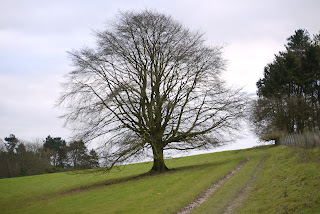Ox Drove
It was a lovely morning at home, with a bright blue sky, and it suddenly felt exactly right to do a bit more of the Wayfarer's Walk. Naturally, by the time I reached the start it was cloudy with a threat of rain. I picked up the route by Bunkhanger Copse and followed a pleasant path along the edge of the wood to emerge on a muddy track with fields on both sides.
The track crossed a road and became the wider and better Ox Drove. I met some chaps on motorbikes here who said they were enjoying the challenge of staying on their bikes as they slid this way and that in the muddy ruts in the track.
The route then crossed the A343 and became tarmaced for a while until it reached this splendid building. It is Grotto Lodge (Grotto Copse is opposite), a gatehouse of Highclere Park.
The Lodge was followed by a pleasant track with fields to the left and woodland to the right.
After a while you reach a vantage point marked on the map as Rabbit Warren, at 260m. The track now descends with wide views over open country all around.
The fractionally higher Beacon Hill (261m) is a major landmark to the east (left).
Time was now almost up: I would have to turn round if i wanted to get back to the car before it became dark, so I descended another quarter mile / 50m of descent and began to retrace my steps just short of this fine oak tree.
Conditions: cloudy with a threat of rain which fortunately did not materialise, but quite mild.
Forward distance: 3 miles; distance now traveled 6 miles.
Map: Explorer 144 (Basingstoke, Alton and Whitchurch).
Rating: three and a half stars.
Sightings
I was surprised to see a few examples of Red Campion still in flower.
I was even more surprised to see this fantastic growth on the edge of a fallen branch.
A bit of Googling identified it as the jelly fungus Tremella mesenterica, known as witch's butter in the US. In the UK the name seems to denote a similar looking but black fungus, Exidia glandulosa.













